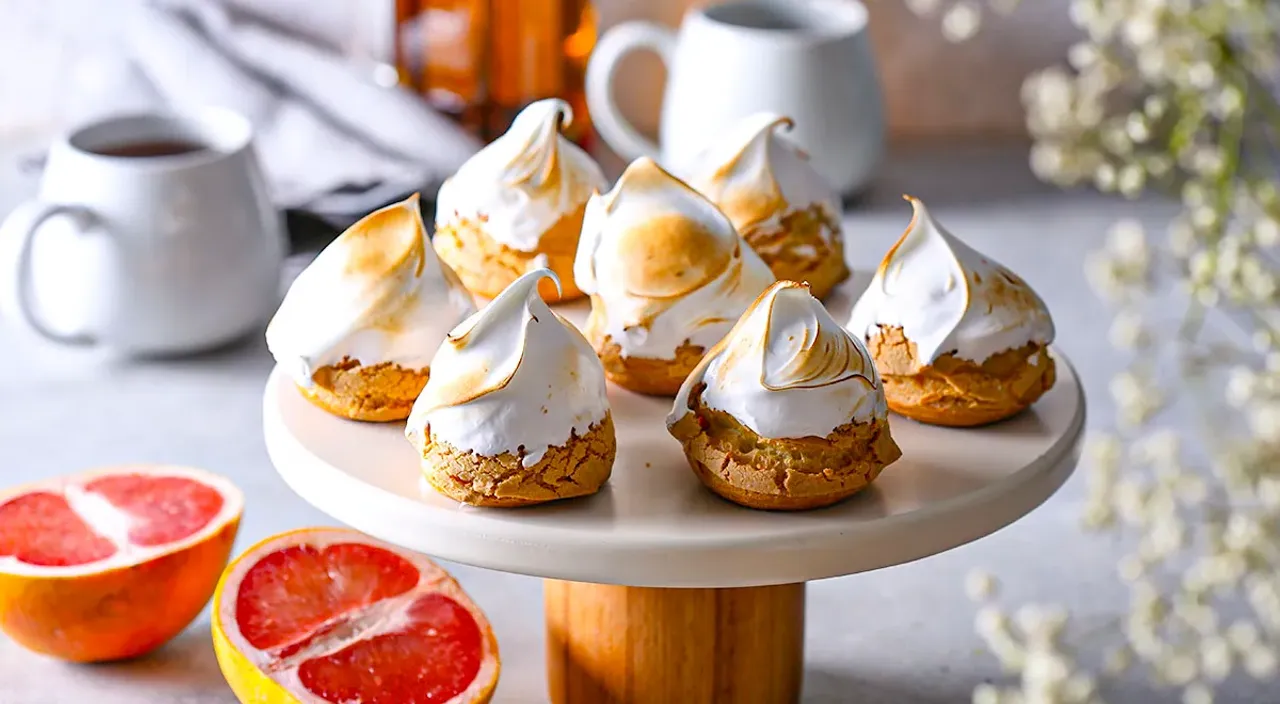
Cooking Time
2 h.
Serves
12
Difficulty
Don't want to rewrite the link? Scan the QR code with your camera and go to this page!
On iOS, you can use the built-in camera; on Android, you need to download an application to scan QR codes.
About This Recipe
The recipe for Shu cake with coconut and grapefruit from the pastry chef of the Four Seasons Lion Palace Hotel (St. Petersburg) Irina Lylova is not an easy task, but it is described in such detail that you will definitely be able to prepare Shu at home if you follow all of Irina’s recommendations. Why are these little choux pastries called shu? The name comes from the French choux, that is, “cabbage” - the uneven surface of the round cake, covered with cracked craquelin, reminded the author of the recipe of a small cabbage, hence the name.
Ingredients List
Total Ingredients: 18
Serves:
Flour - 80 g
Butter 82.5% - 70 g
Egg - 3 pcs.
Milk - 75 ml
Water - 75 ml
Sugar - 3 g
Salt - 3 g
Corn or wheat flour for dredging - 30 g
Almond flour - 15 g
Butter 82.5% - 25 g
Powdered sugar - 25 g
Coconut milk - 400 ml
Corn or wheat flour for dredging - 30 g
Sugar - 30 g
Coconut oil (optional) - 40 g
Egg whites (5 pcs) - 5 pcs.
Sugar - 320 g
Grapefruit - 1 pcs.
Nutrition Facts
Serves:
🥓
Fat
233г
🍚
Carbohydrates
497г
🥩
Proteins
77г
🔥
Kcal
Daily Values
Preparation Steps
Step 1
Prepare the choux pastry. Pour water and milk into a saucepan, add butter, add sugar and salt and bring to a boil. Remove from heat and add flour. Stir vigorously until smooth and cool slightly, 5 minutes. Add eggs to the dough one at a time, mixing with a mixer after each. You should have a soft, elastic dough. Place it in a pastry bag and leave for 30 minutes.
Step 2
Line a baking tray with baking paper. Pipe circles of dough with a diameter of 4 cm. Place the baking sheet with the cake base in the freezer or just in the refrigerator
Step 3
Prepare the croquelin. Grate the butter. In a large bowl, combine both types of flour, add butter and powdered sugar and knead with a fork to form a stiff dough. If the dough crumbles too much and does not come together, add 1-2 tsp. cold water. And if the dough is too soft, add a little almond flour.
Step 4
Place a sheet of baking paper on the work surface and lay out the croquelin. Cover with a second sheet of paper and roll out into a very thin layer, to a thickness of 1-2 mm. Using a mold or glass, cut out circles with a diameter of 7 cm. Place them in a container, sandwiching the dough with baking paper so that the circles do not stick together. Place the container in the freezer.
Step 5
Prepare coconut cream. In a small saucepan, combine coconut milk with flour and sugar and whisk until smooth. Place the saucepan over medium heat and bring to a boil. Continue heating the cream for 30 seconds, without stopping stirring with a whisk. Add coconut oil or butter and remove from heat. Cool slightly and puree the cream with a blender. Cover with cling film and place in the refrigerator for 2-3 hours to stabilize.
Step 6
Preheat oven to 165°C. Remove the baking sheet with the frozen dough and the container with the croquelin preparation from the refrigerator. Place 1 cup of croquelin on each cake, place the baking sheet on the middle rack of the oven and bake for 35 minutes. The cakes should rise and the top layer should crack nicely. If the cakes have not risen, continue baking them for another 5-7 minutes. Do not open the oven door during baking to prevent the cakes from settling. Leave the cakes to cool in the oven for 10 minutes, then remove and place on a wooden board in a single layer. Let the cakes cool completely.
Step 7
Peel the grapefruit and separate into slices. Carefully remove the bitter film and break the pulp into segments. You should not cut grapefruit slices with a knife, as a lot of juice will be released. Trim and set aside the top of each brownie. Fill the brownies with coconut cream, add a grapefruit segment to each, cover with the cut top and press lightly. Place the cakes in the refrigerator to allow the cream to set and the tops to hold together more tightly.
Step 8
Prepare the meringue. Pour the whites into a metal bowl and add sugar. Place the bowl over a water bath and heat, whisking constantly, until the sugar is completely dissolved. During this time, the mass should warm up to approximately 60–66 °C. During the process of heating and beating, the mass will turn white and become viscous. Remove the saucepan with the meringue from the heat and beat with a mixer at medium speed, 3-4 minutes. The meringue should turn into a stable elastic mass.
Step 9
Remove the cakes from the refrigerator and decorate with meringue. It is convenient to cover the cake with meringue using a teaspoon or simply dip the top of the cake into it. If desired, the meringue can be lightly scorched with a burner.
Enjoy your meal!
Follow the instructions step by step
